#(they're a migratory species)
Explore tagged Tumblr posts
Text
animorphs is funny because the kids spend almost the entire series turning into birds of prey to fly in virtually every scenario while complaining about how they have to space themselves out so it doesn't look suspicious that all these rare raptors are grouped together, about how birds of prey often have to do a lot of hard flapping work to fly in some situations they're not meant for, about tiring out easily, etc. to the point where it starts getting weird and confusing that they literally always use those bird morphs instead of thinking to turn into e.g. migratory geese for certain situations as per their general capacity for pragmatism. and then in literally one of the last books in the series some of them turn into geese to fly long distance and spend the entire time going "wtf this is great why the fuck didnt we do this earlier holy shit." and also the answer to that question is at least in part "one of the animorphs is just literally on all levels including physical a hawk that gets snooty about bird species he thinks suck and would have been really annoying about it"
7K notes
·
View notes
Text
It may seem unthinkable to us today, but once it was normal for the response to hearing a species was in danger of extinction to be "Let's go shoot a few before they're all gone!" This wasn't just among trophy hunters and wealthy collectors who felt entitled to acquire any species they wanted regardless of the impact, but biologists, museum curators, and other naturalists of varying sorts. Today conservationists and scientists have a much more enlightened and informed view of how to respond to a species' impending extinction, but this attitude has been hard-won over the past century.
Arthur Augustus Allen may not be as well-known as John James Audubon, but this ornithologist was incredibly instrumental in getting people to stop shooting rare birds with guns--and shoot them with cameras instead. As chairman of the American Ornithological Union's Committee on Bird Protection, he used his role to establish ethical resolutions that prohibited the taking of rare birds from the wild (in violation of the Migratory Bird Treaty Act, no less) and emphasized the observation of live birds in the wild over killing more for preservation and study.
We would do well to emulate Allen's example. Today there are still greedy people who look at a forest and only see dollar signs, or whose only interest in an open area of wilderness is the mineral rights under the soil. They see a pair of antlers as a trophy (and leave the meat to rot), and consider any inconvenient animal like a gray wolf or prairie dog only fit to exterminate. Yet Allen is a symbol of resistance against the purely acquisitive, extractive approach to nature, and how education can change minds and hearts.
So to those of you working to inform the general public about the value of nature in its own right, and not just for what we can get out of it--keep up the great work! Arthur A. Allen certainly wasn't the only person who worked to get the word out about the need to protect dwindling species and their habitats, but I think his efforts deserve to be added to more popular knowledge of conservation.
#birds#birding#ornithology#conservation#environment#nature#wildlife#animals#ecology#science#scicomm#endangered species#extinction#animal welfare
543 notes
·
View notes
Text

Chapter 74 of that fic about human Bill but he's not in this chapter so forget about him: Ford and Dipper go cryptid hunting!
This is pretty much a standalone chapter so if somehow you stumbled on this without seeing the rest of the fic, u can just, read it by itself as a standalone Dipper and Ford adventure. It's funny. Promise.
####
The camera turned on to reveal Dipper, illuminated sunset orange and cast in heavy shadows, holding the camera out at arm's length. "Welcome back to Dipper's Guide to the Unexplained, anomaly #175: the Fremont Nightwigglers!" He held up a paper title card in his free hand. "I'm Dipper Pines, and today I'm honored to introduce our special guest star—" he turned the camera around to focus on Ford from behind, "—the one and only Dr. Stanford Pines, PhD times twelve—"
Ford laughed self-consciously. "Dipper, nobody's going to recognize my name outside of a few highly specialized academic fields—"
"—the scientist who developed the Theory of Weirdness—"
"That paper isn't even ready for peer review yet, and I can't take all the credit—"
"—and the coolest dimension-hopping monster-fighting mystery-investigating great uncle in the world!"
Ford paused thoughtfully. "Okay, I'll take that one."
"Tonight, we're on the trail of the Fremont Nightwigglers." The recording cut to CCTV footage from a much higher-budget cryptid-hunting show (which Dipper had recorded by aiming the camera at the TV). The footage showed two marshmallow-like creatures that seemed to consist solely of heads, long legs, and feet—smooth, ghostly white, and featureless except for black eyes. They wore denim jeans that covered their bodies from ankles to waists, and their legs seemed to bend jointlessly, like an octopus's arms or an elephant's trunk. "These weird armless creatures have been seen up and down the west coast states, leaving behind a wave of jeans thefts at clothing stores; but by the time local law enforcement has ruled out any human suspects, the true culprits are always long gone."
The recording cut back to Dipper, who'd taken the lead so he could turn around the camera and aim it at both himself and Ford. "Based on investigative research done by Dr. Pines in the 80s, we believe the Nightwigglers have a migratory route several years long that passes through California, Oregon, Washington, and Canada. More research is needed to find out if they travel as far as Alaska or Mexico. Locals believe each Nightwiggler creates an individual burrow around a communal gathering spot to hide in during the day, and at night they assemble in the communal spot to travel or forage in nearby towns."
Ford threw in, "Based on what the townspeople told me about their habits, they've been in Gravity Falls much longer than usual. It typically takes them a week or two to pass through the area, but this year there have been sightings for more than a month. Perhaps we'll find out why."
"And thanks to a hot tip from an in-the-know local"—the recording cut to a few seconds of footage of Wendy proving she could do a handstand on the split-rail fence around the Mystery Shack—"we know which assembly spot they're currently camping around! Tonight, we're trying to get the first deliberate footage of a Nightwiggler..." Dipper lowered the camera and turned toward Ford, "Hey, what'll we call a group of them? A flock? Herd? Meeting? If we're the first investigators to officially document the species, we get to come up with the name , right?"
Ford considered the question. "What about a wobble of Nightwigglers? Since their legs are so... wobbly."
"Sure, that works."
"Is this really your 175th episode?" Ford asked. "I've missed quite a few."
"Ye—well..." Dipper lowered the camera. It recorded his shoes as he walked. "So far I've got a list of 175 anomalies I want to do an episode on, but I've only recorded and posted thirty-something. I think you've seen them all except the two I've done this summer." He sighed. "I'm... kinda disappointed by it, honestly."
"Why? You should be proud of your work so far! You're the only person in the world who's caught footage of the Hide Behind."
"By accident."
"Because you learned how to identify its call, chased it through half the forest, and were prepared with the right equipment to record it. That wasn't luck, Dipper—that was your hard work."
"I guess," Dipper said grudgingly. "I just... wanted to have a lot more produced by now."
"Wh—You started these last June? That's about one every two weeks. That's a very impressive output."
"I made most of them last summer, I hardly did any over the last school year or this summer."
"You've been focusing on your studies, that's good."
"Yeah, but what about this summer? All I've done so far is borrow some of Robbie's music video footage to make an episode about zombies and record some footage I haven't edited yet about Pacifica's alpaca thief. I didn't even get any footage of the haunted doll crane game before it disappeared. Most of the time I've been just... hiding in Soos's room playing Bloodcraft: Overdeath"—(under his breath Ford muttered "Blood-craft over death?")—"or hanging out with Wendy and her friends, or helping Soos with the Mystery Shack, or just trying to avoid..." He trailed off, suddenly conscious of the camera still aimed at the ground. It had started recording footprints drying in the mud after the recent rain: soft indents like the pads of paws, but with no distinct toes, about the size and length of human feet. Dipper lifted the camera to better record the trail they were walking down.
"Well... there's nothing wrong with taking a break during the summer," Ford said. "Especially considering that your last summer was... quite a bit more exciting than most kids'—"
"That's just it!" Dipper said. "Last summer I did so much! I investigated your disappearance, I filled half of your third journal, I helped stop the apocalypse, I wrote a book with Mabel about solving mysteries and doing fun stuff, I recorded like twenty Guides to the Unknown... Compared to that, this summer I feel like I'm—falling behind."
"Falling behind what?"
"I don't know. But—I just—I... feel like..." He trailed off with a frustrated sigh. "I don't know."
Ford offered, "Maybe, like you're not living up to your own potential?"
"Yes! That's it," Dipper said. "I'm not trying to grow up too fast, I'm just worried I'll grow up before I've done all the stuff I'm supposed to do now. Like I'm already running out of time."
"Hmm..." Ford let out a long, thoughtful sigh. "Dipper, I'm probably the wrong person to be giving this advice, considering that I'm not exactly... the paragon of moderation when it comes to pursuing professional ambitions. But—remember that you're only thirteen. Right now, you don't need to be worried about graduating valedictorian and starting up an anomaly-hunting show and doing groundbreaking research into previously-unknown strange and wondrous creatures," Ford said. "You just need to focus on graduating valedictorian first. That's all I did with my high school years, and after that I still managed to rack up multiple PhDs before age 30. You've got plenty of time!" He said this with the confidence of a man who didn't realize having his life derailed by a manipulative alien villain was the only reason he didn't burn out hard by 1984. "Outside of that, just... worry about being a kid."
"Yeah. I guess you're right. Thanks, Grunkle Ford," Dipper said. "I keep worrying, though. I keep thinking, what if I'm wasting all my time on stuff that... just... doesn't matter? What if nothing I'm doing is actually important?"
Ford was silent a moment. "That's... a very existential question for your age. How long have you been worrying—"
Dipper hissed, "Grunkle Ford!" He jerked his camera up. "Is that fire?!" There was a faint orange glow in the distance between the trees.
"I think it is!"
Dipper whispered, "That's where I found the Nightwigglers' abanadoned campsite last time!"
"Did you see any signs that they knew how to start fires? Remains of a campfire?"
"I didn't notice anything."
"It could be a Scampfire..."
As quietly as they could, Dipper and Ford edged through the trees, Dipper all the while pointing the camera toward the light, until they found a narrow gap between two trees from which they could peer into the clearing.
There were three or four dozen Nightwigglers milling about in little clusters. Several had lit torches—sturdy sticks with the ends wrapped in fabric—which they carried by sticking the ends of the torches into their jeans' pockets.
"Dipper, look at the tops of their torches," Ford hissed. "Is that shredded denim?"
The camera zoomed in on the nearest torchbearing Nightwiggler. "I think so."
"We already knew they wore clothing—but they can make tools, too? How advanced are they..."
Ford trailed off as the clustered Nightwigglers separated, spreading out evenly into several rings. As the camera recorded, they began emitting a synchronized muffled humming; and then they began dancing, kicking their legs and turning in circles together. "Whoa," Dipper whispered. "Is this some kind of ritual?"
"What's its purpose?" Ford whispered back. "Recreation? Religion? Some sort of cultural event—?"
"Hold on. I think I recognize the song."
Ford and Dipper fell silent, watching in silence as the dance repeated a couple of times.
The Nightwigglers were doing the Hokey Pokey.
"Fascinating." The camera lurched sideways, and then turned toward Ford. Ford had stolen Dipper's journal from out of his vest pocket and was hastily taking notes on a blank page. "I had no idea Nightwiggler culture was so influenced by human culture. An hour ago, we didn't even know Nightwigglers have a culture. When could they have observed and learned the Hokey Pokey? It's not exactly a nighttime dance—do they spy on humans during the day?"
Dipper said, "What if we learned the dance from Nightwigglers?"
Ford stopped writing, looked up, and stared at Dipper, mind blown.
Dipper jerked the camera back toward the Nightwigglers as they filed out of the clearing. "Hey! Where are they going now?"
Dipper and Ford waited until the last Nightwiggler had left; and then they quietly followed.
####
After several minutes of silence except for the sound of footsteps, Ford said, "Are we headed toward Mabel's Fault?"
Dipper groaned. "I got enough of this place last week."
"Agreed."
"Hey, you know Bill said we should rename it 'Bill's Fault'?"
Ford huffed. "Did he really? I don't believe it."
"Yeah. He tried to play it off like, 'oOOoh, I just want creEDit—'"
"That sounds like him—"
They came to a stop as the camera spied the Nightwigglers standing in the clearing around the fault, then they quickly moved off the path into the brush and crept closer. "What are they doing?" Dipper asked as they inched up to the tree line.
"I don't know—they're packed too tightly together for me to see."
"I've got an idea. Hold this." The camera bounced as Dipper passed it to Ford, who watched as Dipper climbed up one of the pine trees around the clearing.
"Careful! There aren't a lot of low branches that can hold your weight."
"It's okay, Wendy showed me how to do this." Dipper held out his hand for the camera.
Ford passed it up to him. "What do you see?"
The camera foused on Mabel's Fault. "The Nightwigglers closest to the fault are taking off their jeans, ripping them into two separate legs, and... tossing them in the fault? Have you ever heard of this?"
"Never."
"Like a dozen have done it so far."
"Perhaps that's why they have to steal so many pairs of pants? But why..."
Dipper gasped. Tiny Nightwigglers had begun squirming out of the fault, each wearing a single denim pant leg, crawling around like inchworms with half the pant leg trailing behind them. The bigger Nightwigglers picked up the little ones with their feet and swaddled them in the excess fabric. "They're—I think they're baby Nightwigglers! Coming out of the fault!"
"Amazing! Is this how they reproduce?" Ford asked. "Is that why they travel the west coast—are they following the San Andreas Fault and the volcanoes in the Pacific Northwest?"
"Maybe that's why they've been in town so long," Dipper said. "Mabel's Fault wasn't here the last time they passed through."
"We'll have to find out what other towns they stay in the longest. How far is Fremont from the fault line—?"
"Hey," Dipper said, "A bunch more Nightwigglers took their jeans off. They're tying them in a circle." One of the torchbearer Nightwigglers knelt down and bowed forward, setting the jeans ring on fire; and it was tossed into the fault. The Nightwigglers that weren't carrying infants formed a circle and began Hokey Pokeying toward the fault.
"That definitely looks like a ritual," Ford said, "but why? To celebrate the births...?"
The ground rumbled. Dipper gasped and slipped several feet down the tree before he caught himself. When he refocused the camera, Mabel's Fault was several feet wider, and a fiery glow was rising up from within.
An enormous Nightwiggler, fifteen feet tall, climbed out of the fault. It wore a crown of flaming denim and tattered pants formed by stitching together many pairs of decades-old jeans. The Nightwigglers bowed down.
"Good lord," Ford breathed. "What is that? Did they summon it, or—or was it always down there?"
The giant Nightwiggler watched regally as its subjects danced around it. As they spun around and completed another repetition of the Hokey Pokey—that's what it's all a-BOUT—the giant punctuated the end of the dance with a ground-shaking stomp.
Dipper lost his grip on the tree. He and the camera crashed to the ground with a yelp.
"Dipper! Are you alright?!"
"Ow... fine, probably just bruised."
The camera caught Ford kneeling to help Dipper sit up, and then Dipper grabbed the camera again as he stood. He pointed it back at the clearing.
Every single Nightwiggler, babies and giant included, was staring at them with wide black eyes.
Ford said, "Uh oh."
The giant let out a bellow like a muffled hunting horn.
The Nightwigglers charged.
Dipper and Ford ran away through the brush, screaming.
####
Dipper pointed the camera at his face. His hair was plastered to his forehead with sweat and his cheeks and arms were covered in small branch scrapes. "Still works," he reported to Ford.
"Great," Ford said. "That thing's hardy."
The camera jerked as Dipper tried to set it on a tree stump.
"Well, we got away with our lives," he said. "But... not without some losses."
He got the camera settled and backed up. He was wearing his vest zipped up around his hips like a skirt. Ford's trench coat was conspicuously buttoned up, and his legs were bare between his coat and boots. They both looked sheepish.
Ford said, "We've acquired some invaluable anthropological data, though."
"I'm calling this investigation a triumph," Dipper said.
Ford offered a hand. "High six!"
In the background, a skinny-legged Nightwiggler wearing Dipper's shorts darted through the trees.
####
(It's about time Dipper get a little personal attention. Hope you enjoyed and I look forward to hearing y'all's thoughts!)
#dipper pines#grunkle ford#stanford pines#gravity falls#gravity falls fic#gravity falls fanart#fanart#my art#my writing#bill goldilocks cipher#(Dec 12 edit: chapter has been renumbered)
966 notes
·
View notes
Note
bird question: do you know any fun facts about Starlings?

Starlings are rather interesting birds, though they have a bad rep in America because when most people think of them, they think of European Starlings. It's actually said we have Shakespeare to thank for that. In 1890, a man named Eugene Schieffelin released 100 European starlings (sturnus vulgaris) into central park, supposedly claiming he had planned to bring every bird species mentioned in Shakespeare's works to North America. In reality, historians suspect he was just trying to control the local insect population. Regardless of the reason the starlings spread out fast, they're avid scavengers, highly social, and competitive to the point they've even been known to push other birds' eggs out of nest boxes. Their large migratory flocks (reaching upwards of 100,000 individuals), aggressive nesting behaviors, and crop stealing/scavenging behaviors are perfect for the english plains where they naturally reside, but damaging in rural America. Additionally, while European starlings are the most common and well-known species, there are actually an estimated 128-131 different species of starling, belonging to the family Sturnidae, starlings are highly intelligent, excellent at mimicry, striking to look at, and recognized as one of the most social types of birds. I can't talk about them all here, the post would be too long, but there are a few notable ones I'd like to include pictures of.

^this is an Emerald Starling (Lamprotornis iris) a non migratory species native to West Africa. They're great bird parents, with both male and female birds tending to chicks.

^next is the Greater Blue-eared Starling, they're seasonal migrants with a native range spanning over most of Africa. I think this bird is probably the closest I'll get to seeing the color olo.

^Probably the most popular starling is the Violet-backed Starling (Cinnyricinclus leucogaster) native to Sub-Saharan Africa. There are very few birds that are truly purple, and these guys are one of the most purple. Truly beautiful birds.

^and last, but certainly not least, my personal favorite, the Metalic Starling (Aplonis metallica), the only species of starling native to New Guinea and the nearby islands. They're crucial to local ecosystems due to their role in seed dispersion, they spread the seeds of the fruits and plants they eat through their excrement.
#birds#starlings#i really like birds#ornithology#fun facts#thanks for the ask!#tim talks birds#that's what I'm calling this new segment now
135 notes
·
View notes
Text
All the porn bots must be following their migratory pattern and moving south for the winter. Remember not to engage them directly; they're an invasive species. Experts advise that you Report Spam/Bot and Block if you happen to come across them trying to establish themselves in your native dash.
85 notes
·
View notes
Text
and you know what whilst we're on the subject of speculative evolution ill throw my hat in the ring: so what we know about zoom so far is that the climate is unpredictable* (given that you can track the effulgent biangle, nef and nox are ongoing and whilst they are moving vim and vex are fixed points that one could measure from, it stand to reason that there is at least some method to this madness - however the method may be just as crazy so we don't know) so any species that could survive and thrive in this world must be able to survive under incredibly changeable settings.
So how would they do this?
I imagine there are a few different mechanisms:
Firstly I picture just a lot of generalist species, meaning species that simply can survive in a wide range of scenarios - they don't require super specific food, they're alright with a wide range of temperatures, so even when the environment is changing rapidly, they can adapt quite fast.
Secondly, I think there would be a lot of migratory species - species that can travel as the climate changes so that they can stick with the environment that is suitable for them.
Thirdly, I'd like to imagine there's a fair amount of symbiosis. While symbiotic relationships (mutually beneficial relationships between two or more species that allow both/all species to thrive) can be delicate, I'd think that on the flipside I feel that having multiple species working together to survive could potentially bolster survivability through change. Idk man tell me about zood lichens it's gotta be great.
And there would have to be adaptations that allow species to "keep up" with the changing environment and that's when things get FUN. Imagine skin cells that can change colour to absorb more/less sunlight. Super active metabolic system to allow for surviving rapid change. Highly receptive sensory organs that allow animals to "predict" when change is coming so that they can prepare. Like the possibilities are endless. I'm sat. Someone talk to me about this.
#dimension 20#thank you cloudward ho for letting me put my zoology degree to good use#cloudward ho#cloudward ho spoilers
34 notes
·
View notes
Text
Worldbuilding: Ecosystems

Ecosystems can be tough, realllllly tough, especially if you're bad at biology. Don't worry I'm going to try to simplify it here, and add some worldbuilding flare
Biodiversity
Biodiversity- the diversity of life
One of the very first things I decide about an ecosystem when worldbuilding is the level of biodiversity. That tells me the level of fauna and flora expected, how healthy the environment is, and how unique the biome is going to be.
The more biodiverse a biome the more it can take, and the quicker it can recover from disaster. As environments lose their biodiversity, they become increasingly fragile.
I typically also decide at this time how bad pollution or unexpected disasters have affected the environment for this ecosystem.

Food Chains
Now we need a food chain. Unless you're looking for a fairly simple start of an ecosystem or just simple ecosystem I actually advise against looking at food chains as a pyramid. In early biology we are given pyramid-like charts because they're easier to grasp, but in all reality food chains are much more loose and fluid than that.
Food chains are more like relationship charts in all actuality. You might have a small predator that is preyed on by another small predator, and then you have carnivorous plants. You can have large predators that consume all across the chart.
There's a lot more roles in the ecosystem than predator and prey too. Take for instance the role of decomposers.
Some kinds of creatures/plants you can consider to diversity an ecosystem
Fungi
Parasites
Decomposers
Symbiotic Species
Large Prey (i.e. Bison, Deer, Elk, Moose)
Megafauna
Birds of Prey
Migratory Animals
Prey Insects vs. Predator Insects
Small Predators
Large Predators
Carnivorous Plants
Flowering/Fruiting Plants
Trees
Invasive Species
Non-Vascular Plants (i.e. Moss, Algae, Liverworts)
Fish
Canopy Animals
Herd Animals
Coral
Small Prey
Pollinators

Apex Predators
Apex predators are the creature or creatures at the "top of the food chain", with no natural predators of their own.
Some examples of natural predators in IRL & fantasy worldbuilding
IRL Examples
Wolves
Tigers
Lions
Bears
Orcas
Fantasy Examples
Dragons
Sea Serpent
Basilisk
Manticore
Gabriel Ultrakill & V1
Ecosystems don't even have to rely on animals, entirely for this role. There could be monsters, robots, interdimensional creatures, whatever you want. You don't even have to keep in the lines of what people generally expect. Maybe there's a bigger fish that preys on dragons, or a monster that eats wolves.
Apex predators are a required member of a ecosystem though, because they keep populations of prey under control. Without the proper apex predators (or with the inclusion of invasive prey) herbivore creatures will eat everything up, killing eventually both the environment and them.

Keystone Species
Keystone species are species that if removed from an ecosystem would cause it to collapse. Apex predators are just one kind of keystone species, and there are many others.
Whether it be a fae-like entity that keeps the trees of an enchanted forests alive, or a prey animal that eats a plant that if left unchecked would grow over everything and starve the environment of sunlight, keystone species are the most important members of a ecosystem.
We humans often don't know when something is a keystone species until it's removed from an environment, but we worldbuilders can do whatever we want.
Think about what kind of keystone species keep your ecosystem together, and what would happen if their populations were to dwindle.

Fauna Versus Flora
Don't forget about plants. They play a major role in making a worldbuilt environment feel otherworldly and fantastical, but vibrant colors, to alien appearances.
Plants don't just add to the atmosphere but serve a role in the ecosystem. They provide resources to intelligent populations, fruits to animals, flowers to pollinators. They can thorny, poisonous, acidic, drug material. Maybe in your worldbuilding there is a thin distinction between what is flora and what is fauna.
Can plants see? Can they communicate with one another? Do they glow in the dark? Are they dangerous? Are they sweet? What utilizes them?
There's is so much to do with trees, flowers, bushes, and so much more.

Invasive Species
Invasive species can range from mild annoyances to an ecosystem to the very harbingers of destruction. The more prevalent travel, trade, and international affairs the more that invasive species are going to hitch a ride one way or another, leading to the eventual spread.
This is especially true for boats, and planes. If you had a teleportation system, I'd say even then too. Whether people are doing it deliberately or not, expect a couple destructive insects to make their way across.

#worldbuilding#world building#writeblr#worldbuilding advice#worldbuilding advise#writing tips and tricks
48 notes
·
View notes
Note
I noticed there was a large archipelago on the styraphant's planet map that appears completely gray, is there any reason for this? Is the island uninhabitable or have the styraphants just not bothered to settle there because it's so far out?
Good eye! It's both because it is kind of far away to get to and because of that, it is inhabited by a different species of sophont! I'm still going back and forth on their design at the moment, but by the time the sytraphants arrive there they are pretty well established. I'm thinking historically, most styraphant populations avoid major conflict by respecting both classical and newly established migratory routes. So a lot of their thought process about em is "well they're using it still and we don't really NEED it.." That isn't to say that there are not SOME small settlements there, but those typically have to be in less than ideal areas or deal with the conflict that comes with moving onto someone else's property.
#tryna get the styraphants tied down before i move onto their planetary siblings#but it is tempting...#but tryna make the new ones still different
43 notes
·
View notes
Text
Daily Shark Fact - 5/2/2025
Today's shark is the silky shark!

The basics: the silky shark (Carcharhinus falciformis) is named for its smooth (in comparison to other sharks) skin, which has very fine dermal denticles that give it a velvety look. They are very active, persistent hunters of the open ocean, and are highly migratory sharks. Along with blue and oceanic whitetip sharks, they are one of the most common shark species found in the open ocean.
Conservation status: vulnerable. Silky sharks are so common they were once thought to be essentially immune to overfishing, but assessments have shown that heavy overfishing has led to regional population declines averaging around 50% worldwide. Silky sharks are heavily commercially fished for their fins primarily, and as they often follow tuna, they're a frequent bycatch as well.
Today's fun fact: many sharks are shy by nature, but silky sharks, who have evolved to be tenacious hunters thanks to the scarcity of food in the opean ocean, are naturally very curious and can be bold! Interactions with humans are rare, but silky sharks are extremely unusual in that they will repeatedly swim up to and bother divers - usually it's the other way around! Bite incidents with silky sharks are still very rare, but they are large sharks that should be treated with caution and respect, and their behavior has been known to force divers out of the water for safety.

18 notes
·
View notes
Text
Today's bug is:




Hemaris Thysbe!
Commonly known as the hummingbird clearwing, this little guy is part of the family Sphingidae, commonly known as hawkmoths.
They're native to North America, and are most commonly found in the eastern USA and southern Ontario [hey! that's where I am! :D]. They're also migratory species. Neat!
Colouration can vary, but typically they have an olive green back, a red abdomen, and a cream underside. Their wings are mainly red with clear windows.
These little guys get their namesake, along with their colouration, from the fact that when they feed they hover in the air instead of settling! Therefore, hummingbird moth.
Unlike most moths, the hummingbird moth is diurnal! They are most active during the hottest parts of the day, but stay out until sunset. Other than that, little is known about their behaviour.
Curious little critters! Go kiss a bug :3
24 notes
·
View notes
Note
Siren world building!!!! Whatcha got so far?
Ok so....my notes are all in one place so I'll do this off the tops of my head. Buckle up tho cause this'll be long. Edit: I lost a lot of the lore as I was compiling it so this might be shorter than I intended it because I cant remember everything I put down. Fml.
SIREN PHYSIOLOGY:
1. Types? Scales?
Sirens come in three types, Tropical/Coral Reef, Open sea, and deep sea.
Tropical sirens have cylcoid and ctenoid scales, as they typically aren't migratory at all. Depending on the type of tail they could have both ctenoid and cylcoid (ctenoid on the back facing parts and cycloid on their bellies/undersides) but most only have very colorful and patterned cylcoid scales. They also have very flowy and frilly fins like betta fish and angel fish. They also appear the closest to how the myths are about beautiful half human half fish people but the difference is that all sirens are covered in scales. Majority of the sirens bodies are covered in scales besides some of the chest area, head, and scalp, especially in the case of tropical sirens.
- side note, the different types of sirens aren't different species of sirens. Its more like morphological and cultural differences like Darwin's finches or the races we humans have made up for ourselves. If anyone sees this and doesnt know, race is NOT biological. If it was then we wouldn't be considered the same species.
Open sea sirens have shark-like placoid scales, which help them move easily and silently in the water to be speed-ambush predators. These types of sirens are also migratory and travel in pods of close family members. They have a tendency to have dull patterns or no patterns at all and have sharklike fins. Since they are migratory they mingle a lot with other open sea pods and have strong family bonds. They have scales all over their bodies and have little hair because it interferes with their swimming.
Deep sea sirens, on the other hand, are scale-less and tend to resemble deep ocean fish, particularly anglers and eelpouts. These tend not to have extensive patterns and are all solid colors. Their fins also tend to be reminiscent of eel skin. These sirens typically also never venture to the surface and it is very rare for any other sirens to meet one as deep sea sirens tend to live alone.
2. Genitalia? If they're mammals, how do they produce milk.
Sirens, no matter the form, have internal genitalia. This leads to male sirens in their human form often being mistaken for human females.
As for the production of milk, they do the same thing that whales do. They also give live births instead of laying eggs.
3. Size and biological sex?
Female sirens are much bigger, stronger, and tend to be bulkier than male sirens. As such females typically cap out at 12-13 feet long in siren form and males tend to cap out at 10-12 feet in siren form.
The biological sex of sirens can only be visually determined by the size of the siren. Otherwise there is no physical distinction between the two. They all tend to have the same or consistent patterns between them, they have the same body builds, etc. Its just that females are bigger and typically stronger than the males. However siren males tend to be faster than the born females.
4. Siren songs? Strength of their voice?
Siren songs have the ability to control human minds and make humans of any gender or sexuality jump off their boats, thus making their ships or vessels ghost ships.
The strength of a sirens voice is determined by their confidence. Older sirens tend to have stronger voices because they are more confident in their uses.
The volume of the songs though is around the volume of a whale call, which is LOUD. Out of the water if a siren uses its call it would be louder than a jet engine.
5. Siren eyes
Siren eyes are unusual because the irises are pearlescent and come in any color that pearls do. They also have fisheye lenses. The shinier the eyes the better. Why did I make them this way? Because its cool thats why.
Also, most deep sea sirens are blind since its dark where they live. They usually use their vestibular senses, smell, and touch in order to tell where they are and where their prey is.
6. What foods can they eat?
Sirens eat mostly fish, shellfish, kelp, seaweed, sea urchins, whale falls, scavenged meals, etc. They can also eat most human foods, but they have an intolerance to fruits and nuts. They can eat them, but its similar to a human thats lactose intolerant. Not that thats ever stopped my OC and his kids from fucking up a couple of mangoes.
7. Human forms, gills, and breathing
All sirens can disguise themselves as human and thus have human forms. Since the sirens size is impacted by their biological sex, female sirens disguised as humans are typically 6-7, sometimes 8, feet tall while male sirens typically come around 4'5-6' even in human form. It is typically only slightly painful to shift forms, but becomes extremely painful if the siren is already ill or exhausted. Most sirens, even if they shift forms often, find it slightly annoying but not much else.
Sirens have two modes of breathing that allows for this to happen. They have a set of human lungs, nostrils, and two sets of gills. Their sets of gills are located on the neck and just below the ribs so that even if one set is above water theres another as a backup. Their gills can also close up the entire way, which to the untrained eye makes them look like scars when in human form or not in use. Their nostrils, when in the water, also automatically close and their gills automatically open.
Switching from nostril breathing to gill breathing and vice versa is typically painful for the first few breathes. As such, young sirens prefer to stay in one form over the other until their teenage years.
Most young sirens after birth will stay only in their siren forms until they are around 5 years old, and then they will begin shifting forms (if applicable to the type) and learning how to walk on two legs guided by a parent siren. Most deep sea sirens never do this, as they tend to stay in the deep ocean. Some open sea sirens do it and the majority of tropical/Coral Reef sirens do this.
8. What do land sirens need to do to stay healthy?
A siren can stay fully out of the sea for up to 3 months without physically damaging themselves past the dulling of skin, hair, and scales. But most sirens will go back to the sea every month during the full moon (because that is when the tides are the strongest) to revitalize themselves. This is what my OC and his children do to stay healthy.
Otherwise, they have boosted immune systems and rapid healing and do not need to do much to stay healthy.
CULTURE OF SIRENS:
1. Money? Economy?
Most of the economy is based on a trade and barter system. An ill do this for you if you give me this or something like that. "I'll give you these fish i caught if you make me a basket" or "I'll make you a fishing net in exchange for this ring" that sort of thing.
Though there is currency for when trade is unavailable, whether it be because the item or service you want is too expensive to trade or because theres no trade etiquette for it. These consist of pretty shells (the more symmetrical, uniform patterns, and unbroken the better) or perfectly shaped and colored pearls.
2. Matriarchal or Patriarchal?
This society is majorly matriarchal with a focus on protecting and raising children. The emphasis on raising children isnt based on social pressure, but more so of the expansion of the pods because giving birth is a rare occurrence. Most sirens only have one to three children in their lifetimes, of which consist of around 100 to 150 years.
The reason that sirens are matriarchal is based on the fact that they are the ones that bear the children. The sirens see this as a divine feat worthy of worship, and also because matrilinial lines are easy to keep track of.
3. Jewelry and tattoos
Most deep sea sirens do not have any jewelry or tattoos because they are mostly solitary and unsociable. However tropical and open sea sirens have lots of tattoos and jewelry to explain.
Jewelry is usually made of braided seaweed, kelp, shells, metals, sea glass, and pearls.
The more expensive materials like metal, pearls, and sea glass are usually reserved as gifts for loved ones or to show family status. Matriarchs and patriarchs (the head matriarch and her first husband) tend to be the receptical of the more elaborate pieces of jewelry. The matriarch of course, receives the *most* elaborate pieces as is pod tradition.
Tattoos on the other hand have meanings. Different tattoos (that i still need to design) have different meanings in the pods. A lot of the tattoos signal different pod families and branches of those family. For example, my OC comes from the key pod even if he branches off and starts his own, so his tattoos contain base elements of the key pods designs. The tattoos must contain the latest pod you belong to. Meaning his children would have the elements of his current pod, and not from the key pod. Does that make sense? This is done so that when children break away from their parents they can start their own distinct family structures while still keeping their roots and easily tracing family trees.
These family tattoos are usually tattooed onto the backs of the sirens, as they cannot be easily hidden or taken away. The other tattoos like warrior tattoos and honor tattoos are placed on the arms.
The most important tattoo anyone could ever get in this society, though, is the tattoo of the child bearer and the child rearer. These tattoos are placed on the stomach around the area of the womb on a female and below the naval on a male and they signify that these two have produced and raised children. Different lines signify how many children you've given birth to or raised.
For example, my OC is a Trans man siren who has given birth to three siren babies but has adopted more children, making his grand total of lines to be 10 because he has raised 10 children.
4. What do they use pearls for? What do they use siren scales for?
They use pearls for many different things. They use it for jewelry, ceremonies, and money. The most common use for pearls is for jewelry that shows status among pods and marital status.
For most jewelry, imperfect pearls are used. That is pearls with unusual shapes, sizes, and colors. Since sirens are matriarchal, the head matriarch of the family will have the more perfect pearls while the rest of the family pod will get the more imperfect ones. The higher in pod status you are the more perfect the pearls.
To propose many sirens will give the sirens of their affection their shiniest scale. If the other siren accepts the proposal, they will wear the scale on a belt. The number of partners a siren has will be shown on the belt (with the different scales) and will be accompanied by a braided seaweed and shell bracelet. The amount of shells on the bracelet, accompanied by a small scale to show who the partner in question is, will show how many years the siren has been married to the other. It is often a big deal when the amount of years on a siren pairs bracelets can't fit on a bracelet and has to be made into a necklace instead.
Perfect pearls are often used as currency or offerings to the divine feminine sea on shrines. More on that in a later post if y'all want.
5. Clothing
It is dangerous for sirens to wear traditional human forms of pants or forms of underwear as theres a risk of their tails being tangled/hurt while ripping the fabric in need of an urgent transformation (because clothes dont change with them) so they usually wear flowy and light things that can be easily untied or tied.
Also, because of the fact that sirens have internal genitalia, sirens are not particularly prudish or ashamed of their genitalia. They often get in trouble with humans for being too exposed because sirens don't have the same version of modesty that humans do.
Most outfits that sirens wear when in human form is similar to these pictures here:

6. Different romantic relationships taboos.
Deep sea sirens do not have much in the way of social lives, so they rarely form romantic attachments to any other sirens, much less aby sirens outside of their own type. It is exceedingly rare to see a deep sea outside of their natural hunting grounds.
Intermixing between siren types isn't taboo. it's just uncommon because of all the different behavior types. Two types of sirens are usually stationary while one type is migratory. The most likely to encounter each other are tropical and open sea sirens.
What *is* taboo however is siren and human romances. Mainly because historically humans have, and in this world still do, hunt sirens and make trophies out of them. There are safe villages that I can elaborate on later in another post if anyone is interested, but they are not the norm. Very rarely do sirens and humans form romantic relationships unless the siren is mostly on land, and when they do form those relationships the older generations of sirens are typically opposed while the newer generations are typically more accepting.
#worldbuilding#sirens#mythology and folklore#my own world#my writing#writing#stories#writers on tumblr#writerscommunity#im also happy to bounce ideas off of one another if anyone is interested#mermaids
13 notes
·
View notes
Note
do U have a favorite fish?
MANY!!
*the only reason I won't include any cephalopods is bc they are technically mollusks and this post will prob be long as-is <o>
Scalloped hammerheads:
RAHHHHH SCALLOPED HAMMERHEADS <333 My favorite of hammerheads.

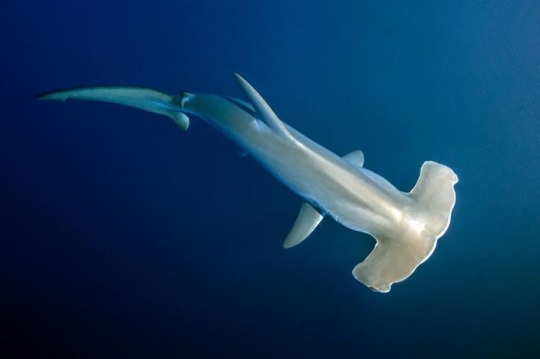
I love hammerheads in general for their look but something about scalloped hammerheads just....it's so good. They have my favorite head shape. Such a weird sentence.
They can live up to 30 years—females maturing at 15 years while males mature at 10—and weigh from 100-200 lbs (~45-90 kg). They typically grow to 6-12 ft (~2-4m). Big fishies!
Gestation periods normally last 8-12 months, and they give birth viviparously—so the eggs hatch inside the mother and are nourished in there until they're born.
Sadly though, like most hammerheads, scalloped hammerheads are considered critically endangered due to overfishing for their fins to make shark fin soup. It doesn't help that scalloped hammerheads are known to school with up to hundreds of their own, making many easier to be caught. Their reproduction is also too slow to repopulate the numbers that are missing. This is something that saddens me. Often. :')
But yeah, I love these sharks very dearly and am constantly hoping we get to learn more about their migratory patterns and other ways of life to further conservation efforts and keep 'em around.
(I had a scalloped hammerhead pin but i cannot find the beanie it's on for the life of me TT^TT but here is where i got it from.)
Several Eels:
EEEELS!! My slithery beloveds. Okay I'll choose uhhhh,,,4(ish!)
Moray eels - The poster children of eels! The most recognizable of 'em probably being the green moray eel.
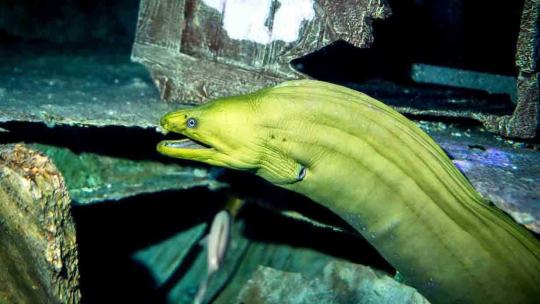
They like to hide in rocks and coral formations and are relatively shy, not often leaving their dens to swim in open water. They are around 6ft (~2m) in length on average, but the largest species (slender giant morays) can grow up to 12ft (~4m)!
Morays also have this neat set of teeth in their throat called Pharyngeal jaws. When they open their mouths to catch their food, these teeth reach forward to securely grab the prey and drag it back into their throats. Lovely!!
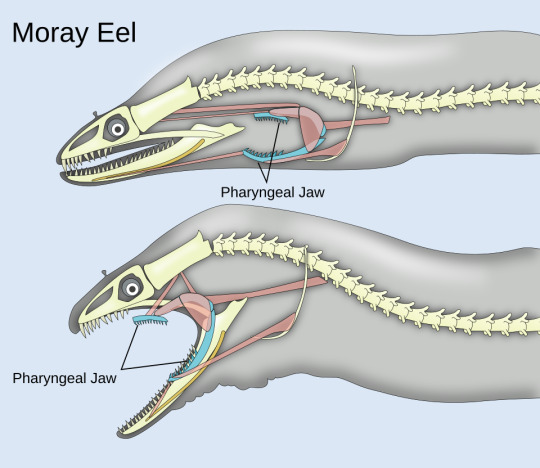
Anyways have this moray post as a bonus bc i love it and it's a favorite.
Ribbon eels - TRANS 👏 EELS 👏. Originally there were thought to be 3 different types of ribbon eels. Turns out though they're all the same, just at different stages in their life!

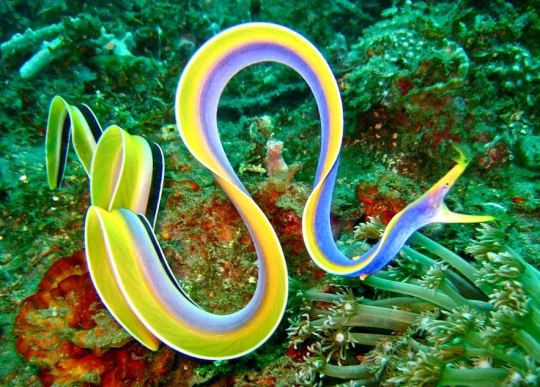
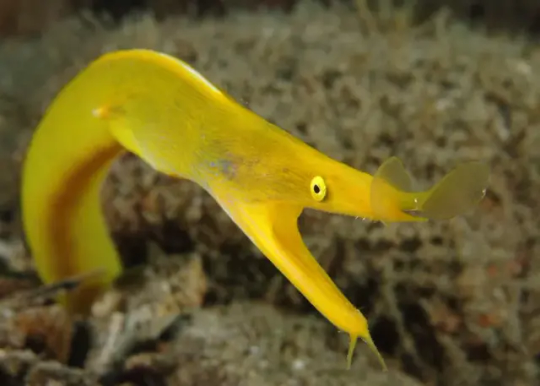
All ribbon eels are born male, where they are black and yellow. As they mature though, they start to gain that blue and yellow pallete and begin to develop female organs! By the time the ribbon eel is entirely matured, they are now female and entirely yellow.
They are technically also morays, but they get their own little spotlight for how fabulous they look :)
Electric eels - THEY AREN'T!! They aren't 'true' eels! They are actually a type of knifefish!!
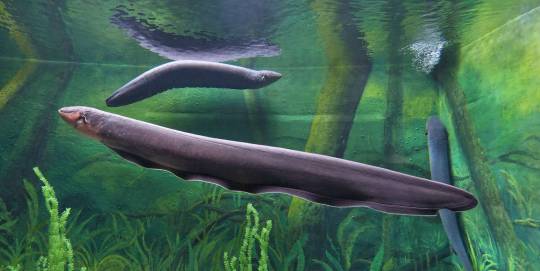
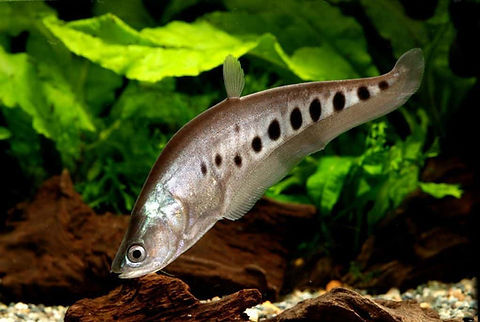
The first is an electric eel, and the second is a clown knife fish. They're called knife fish due to the lack of dorsal and caudal fins, only an extended anal fin on the underside of their bodies. Thus their shape! I'm still keeping the electric eel in this category though because it's cute and sneaky like that.
European conger eels - I love these dorks. So so much.
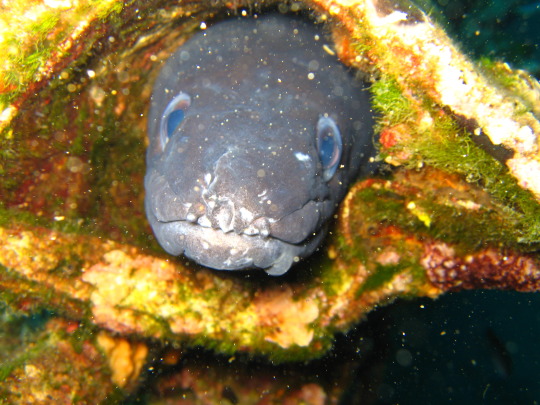
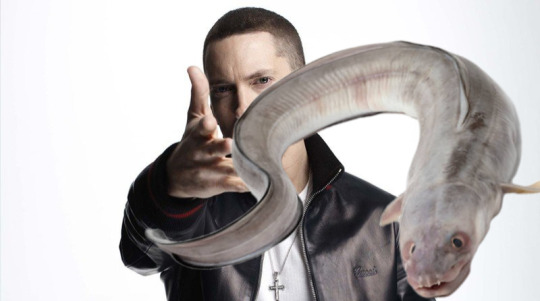
This no-thought-behind-its-eyes creature is the HEAVIEST EEL WE KNOW OF.
They can get up to 9 ft (~3m) long and the larger ones weigh up to 220 lbs (~100kg). 220 lbs of eel.
There may also be cases where they share dens with a lobster; the lobster will eat the conger's waste and extra food. But whenever the lobster molts and is vulnerable, the eel will typically just. Eat it. So. :/
Deep-sea sillies:
HAGFISH - I've held such a fascination towards hagfish since i first found out about them.
They are jawless fish. They still have a skull though. Oh but they have zero (0) vertebra? Of course.
When eaten, they coat themselves in icky slime that covers the attacker's gills to force the predator to spit them out.
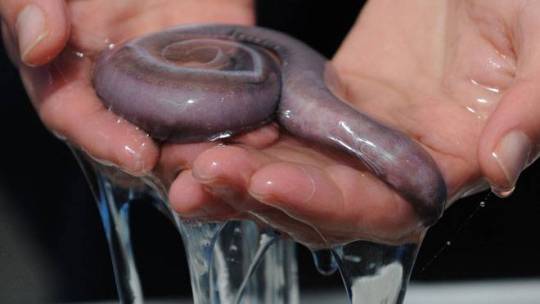
This goo can also backfire and suffocate themselves. So what do they do? Turn themselves into a knot to brush that shit off!
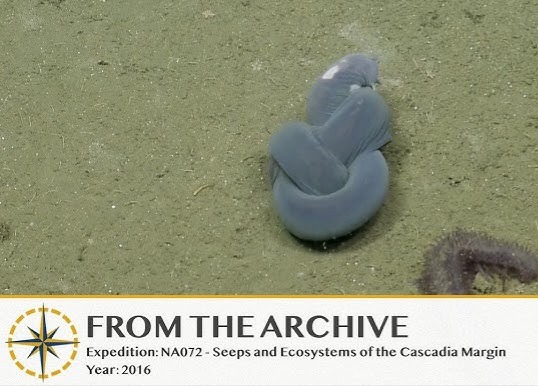
????
They also turn themselves into these knots so that when they bite into chunks of carcass—they're scavengers btw—they are able to use the knot as extra force to help them pull the meat off easier.
???? You do you, I guess??? Bonkers fish, love them. Moving on.
Snaketooth fish - huh

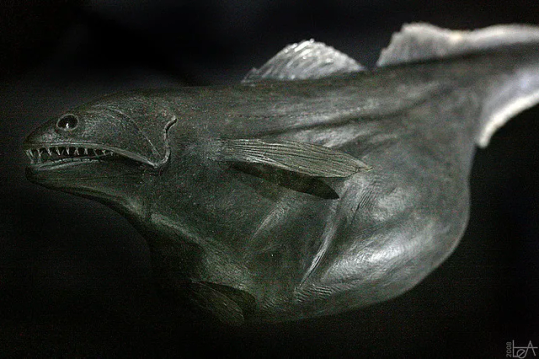
Yeah, that large bit of skin underneath it is its stomach. It. Its pelvic fins aren't fused together so its stomach can just streeeetch. This 10 inch (~25 cm) fish is able to eat other fish twice its size and 10x its own weight. And it swallows its food whole. Crazy? Uh.
Well they also die from this. They lack the ability to digest some of their larger meals in time before it starts to rot in their gut, causing the buildup of gases from its prey to just...rupture the snaketooth's own stomach. And inflate the now-dead fish into rising to the surface.
Phenomenally absurd and wild, like many fish that live in the twilight zone and deeper. 10/10. Marvelous.
That's all my goofs. Honorable mentions go to: oarfish, thresher sharks, and pelican eels. Ty for reading! :D
#Talk talk talk#Oughdg not an expert but i do love these fish....i hope i explained well enough#Long post#Fi...fish#If there are typos—nuh-uh#Answered
12 notes
·
View notes
Text
Since I covered the nantuko in my previous post, it's only fair that I cover the moths in this one. While Kamigawa has many normal-sized moths, these moths in particular are sentient and form bonds with other species (usually humans and kitsune in modern times, we'll get into that) to carry their riders into battle.
The moths are, according to my coworkers who are closer to the size of the average rider, between the size of a horse and a very large horse. I did not ask further questions about this because honestly I was very confused at how horses were being measured.
Many people would argue that they don't count as sentient beings, but those same people also argue against the akki and nezumi counting, so they're mostly just assholes anyway. Regardless, the moths are capable of understanding the languages of other species in Kamigawa, have a vague understanding of the economy and a much stronger understanding of bartering and trade, and know how to avoid things that will kill them in the middle of battle.
They are also, fundamentally, very simple. As long as they're fed and allowed to fly, they're content to let others put armor on them or ride them. Their favorite foods are these kinds of...mineral bricks that the Imperials make. It's got this hard skin on the outside that only a moth's tongue can pierce, then it's full of liquid minerals. Typically, each ride per person will require giving the moth one brick each.
Traditionally, the pre-Imperial Court governing body of Kamigawa was the only faction that had the means to feed, stable, saddle, and care for the moths. Modernly, the Imperial Court is still the main one doing that, and their riders are essentially raised beside them when they find one to bond with. Several have also become more wild and migratory, traveling between the Jukai Forest and the Sokenzan Mountains. The cold doesn't actually seem to bother them like it bothers other Kamigawan races.
Other than that, there's not much to be said about the moths. They're here and they're happy, and that's all we can ask for here in Kamigawa.
11 notes
·
View notes
Note
what do mermaids think of whales
okay great question lol it's not concrete in my head yet but basically there are only a couple different whale species which live in the mer ocean (name pending) so we have blue, humpback, sperm, n atlantic right. also orcas.
the baleen species are kinda mysterious bc there aren't v many of them and they can actually escape the mer ocean (ppl are studying this) and they're really only there in winter bc of migratory patterns. but at the end of the day they're just There and it's fun to see one but not very rare (in winter). but the whole whalesong/whale noise schtick is a little bit like birdsong to them just a little. in terms of them escaping mer ocean it's a niche theory that their noise actually counts as a weird kind of chorus and they are doing escape/reentry magic but idrgaf abt that tbh. basically you just see the baleen species swimming abt above capital city/kelp/meadows and over the ravine and you can hear them and it's super cool but not very very special
the sperm whales don't migrate so they're always there diving in/out of the ravine hunting giant squid which mainly stick to the middle of the ravine where there isn't much except undeveloped hydrothermal vents and ofc. the gash at the centre of the world. both giant squid and sperm whales are really rare and it's like. woahhh to see a sperm whale but if you go down into the ravine you can almost always hear them. and bc they go right into the gash at the centre of the world which IS rebirth and kick up nutrients etc they're kind of like angels. ch23 or whatever. they never try to eat merpeople. basically they are mysterious angels with long running associations with the void below/gash and you usually have to swim into the really really dark bits to find them. but their hunting songs are like constant birdsong to ravine people
#wish it was cold enough out there for narwhals lol but that's just the 2016 in me speaking#bbi maelstrom#sheppo
13 notes
·
View notes
Text
benthic zone lenin: actually migratory species that stop at vent ecosystems and then die on the seafloor (thus transfering energy from the vents to the seafloor) are a very significant source of deep sea nutrients and we shouldn't ignore their contribution to the foodweb simply because they're not whales.
48 notes
·
View notes
Text
I have thoughts about Corrin's dragon form. AKA some biology related head canons (they're quite long and a bit gabby)

It's ugly, but in a aw cute insect sort of way.
It must rely on some form of mechanorecptor or electroreceptor (like sharks) in the skin since they seem aware of what's going on around them at any given point.
Why does it have a jaw but no mouth?
Something about the gorilla hands and feet is so pleasing to me, this thing has prehensile digits on both its hands and its feet. So good for gripping. such a climby creature. like a frog.
it doesn't seem to have any of the classic adaptations of a water dweller, so I would hazard a guess that it is in fact not a water dragon of any kind but instead something else. I would like to coin the term Silent dragon as in dragon from the silent/forgotten/whatever else Valla is called place as apposed to divine/fell dragon. (also it has no mouth)
Also my first thought as a biologist is that this big, showy, not very practical (no eyes, no mouth) transformation would be something necessary for the species' mating behaviours, since the closest biological examples that I can think of are Salmon (smoltification) or sheepshead wrasse (and similar fish with sequential hermaphroditism). All of the above have dramatic phenotypic change in body size, shape, and function, all of which are for mating. (it should be noted, all of the above are permanent)
other showy displays like the magnificent riflebird are also for mating. Obviously it's not for mating, or a Kana wouldn't be possible without a second corrin-esque dragon. But every biological example of dramatic transformation into something larger and more odd is for mating so. yeah.
Also this thing is somewhere between a greyhound and a Komodo dragon. It's so long and shaped.
Anyway, it bums me out a little that I can't make biological sense of the thing since it's essentially glorified origami with bits missing. My best guess is that it's some sort of magic fight or flight response thing.
It is still iconic, but if I was making a dragon I would have a diagram of its various sensory organs and feeding, migratory, hibernation patterns etc. And possibly a nice detailed explanation for odd features like I don't know say an Empty Jaw Bone And Missing Eyes?
14 notes
·
View notes